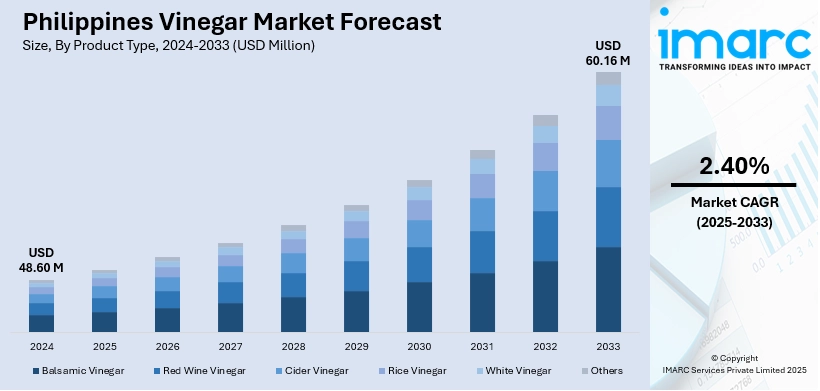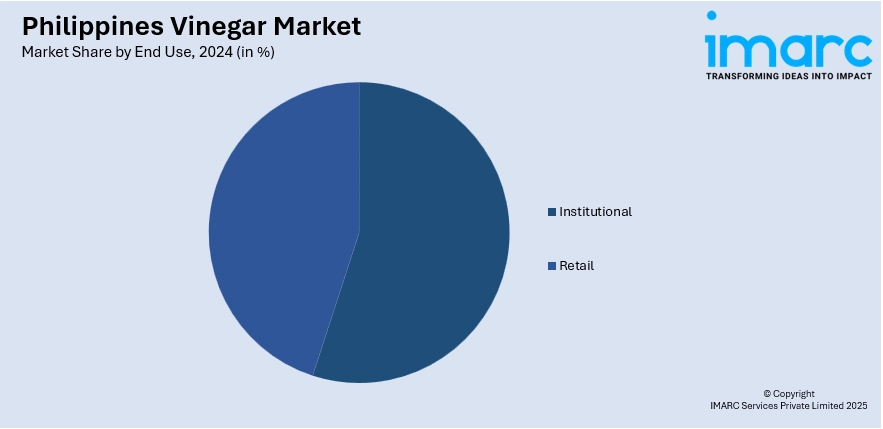
Philippines Vinegar Market Size, Share, Trends and Forecast by Product Type, Source, End Use, Distribution Channel, and Region, 2025-2033
Philippines Vinegar Market Overview:
The Philippines vinegar market size reached USD 48.60 Million in 2024. Looking forward, the market is projected to reach USD 60.16 Million by 2033, exhibiting a growth rate (CAGR) of 2.40% during 2025-2033. The market is witnessing steady growth driven by its widespread use in cooking, food preservation, and as a household staple. Rising consumer preference for natural and locally sourced products, along with increasing demand from the foodservice sector, supports market expansion. Traditional varieties like coconut and cane vinegar continue to dominate consumer preference, while advancements in packaging and distribution are making products more accessible to wider markets, thus strengthening the Philippines vinegar market share.
|
Report Attribute
|
Key Statistics
|
|---|---|
|
Base Year
|
2024
|
|
Forecast Years
|
2025-2033
|
|
Historical Years
|
2019-2024
|
| Market Size in 2024 | USD 48.60 Million |
| Market Forecast in 2033 | USD 60.16 Million |
| Market Growth Rate 2025-2033 | 2.40% |
Philippines Vinegar Market Trends:
Rising Demand for Natural and Traditional Vinegar
In the Philippines, traditional vinegar varieties such as coconut and cane enjoy widespread popularity, rooted deeply in cultural significance and distinct flavor characteristics. Consumers are increasingly appreciating these local options because they are affordable, versatile for everyday cooking, and sourced from the local community. The authenticity and heritage tied to these varieties continue to make them the favored choice over synthetic alternatives. This trend is fostering sustained demand for traditional vinegars while motivating local producers to enhance production and distribution efforts. As both urban and rural households increasingly incorporate these products for culinary and preservative purposes, the market demonstrates significant growth potential. This preference for traditional vinegar underscores a harmony between cultural heritage and contemporary consumer preferences, ensuring that natural vinegars remain fundamental to the country’s consumption patterns.

To get more information on this market, Request Sample
Growing Preference for Vinegar as a Healthy, Chemical-Free Food Ingredient
Consumers are becoming more health-conscious, leading to a marked shift toward natural and chemical-free food choices. Vinegar, known for its digestive, antimicrobial, and preservative benefits, is receiving greater attention as a safe and healthy substitute for synthetic food additives. This trend aligns with the global movement toward wellness, where individuals are more cognizant of how food choices affect long-term health. In the Philippines, vinegar is utilized in cooking and as part of home remedies and wellness practices, further enhancing its relevance. The inclination toward natural vinegar bolsters the Philippines vinegar market growth as manufacturers invest in organic and additive-free products to meet this demand. As consumers express increased trust in locally produced, chemical-free options, this trend signifies a shift toward a health-oriented market landscape that reinforces vinegar’s significance in everyday consumption.
Increased Use of Vinegar in Ready-To-Eat Meals and Processed Food Products
The rising popularity of ready-to-eat meals and processed food items in the Philippines is driving the demand for vinegar as a crucial ingredient. Vinegar is commonly utilized in marinades, dressings, sauces, and as a preservative, making it an integral part of food processing. With urban lifestyles becoming more hectic, consumers are looking for convenient meal solutions, prompting food manufacturers to incorporate more vinegar into packaged foods. Additionally, the growth of quick-service restaurants and the expansion of food delivery services are enhancing the demand for vinegar in commercial food preparation. This trend illustrates how changing consumption habits are broadening vinegar’s role beyond household kitchens. With its ability to enhance flavor, prolong shelf life, and ensure food safety, vinegar’s application in the processed food sector is expected to remain robust. This expansion highlights vinegar’s critical role in meeting the evolving needs of modern consumers.
Philippines Vinegar Market Segmentation:
IMARC Group provides an analysis of the key trends in each segment of the market, along with forecasts at the country and regional levels for 2025-2033. Our report has categorized the market based on product type, source, end use, and distribution channel.
Product Type Insights:
- Balsamic Vinegar
- Red Wine Vinegar
- Cider Vinegar
- Rice Vinegar
- White Vinegar
- Others
The report has provided a detailed breakup and analysis of the market based on the product type. This includes balsamic vinegar, red wine vinegar, cider vinegar, rice vinegar, white vinegar, and others.
Source Insights:
- Natural
- Synthetic
A detailed breakup and analysis of the market based on the source have also been provided in the report. This includes natural and synthetic.
End Use Insights:

- Institutional
- Retail
A detailed breakup and analysis of the market based on the end use have also been provided in the report. This includes institutional and retail.
Distribution Channel Insights:
- Supermarkets and Hypermarkets
- Convenience Stores
- Specialty Stores
- Online
- Others
A detailed breakup and analysis of the market based on the distribution channels have also been provided in the report. This includes supermarkets and hypermarkets, convenience stores, specialty stores, online, and others.
Regional Insights:
- Luzon
- Visayas
- Mindanao
The report has also provided a comprehensive analysis of all the major regional markets, which include Luzon, Visayas, and Mindanao.
Competitive Landscape:
The market research report has also provided a comprehensive analysis of the competitive landscape. Competitive analysis such as market structure, key player positioning, top winning strategies, competitive dashboard, and company evaluation quadrant has been covered in the report. Also, detailed profiles of all major companies have been provided.
Philippines Vinegar Market Report Coverage:
| Report Features | Details |
|---|---|
| Base Year of the Analysis | 2024 |
| Historical Period | 2019-2024 |
| Forecast Period | 2025-2033 |
| Units | Million USD |
| Scope of the Report |
Exploration of Historical Trends and Market Outlook, Industry Catalysts and Challenges, Segment-Wise Historical and Future Market Assessment:
|
| Product Types Covered | Balsamic Vinegar, Red Wine Vinegar, Cider Vinegar, Rice Vinegar, White Vinegar, Others |
| Sources Covered | Natural, Synthetic |
| End Uses Covered | Institutional, Retail |
| Distribution Channels Covered | Supermarkets and Hypermarkets, Convenience Stores, Specialty Stores, Online, Others |
| Regions Covered | Luzon, Visayas, Mindanao |
| Customization Scope | 10% Free Customization |
| Post-Sale Analyst Support | 10-12 Weeks |
| Delivery Format | PDF and Excel through Email (We can also provide the editable version of the report in PPT/Word format on special request) |
Key Questions Answered in This Report:
- How has the Philippines vinegar market performed so far and how will it perform in the coming years?
- What is the breakup of the Philippines vinegar market on the basis of product type?
- What is the breakup of the Philippines vinegar market on the basis of source?
- What is the breakup of the Philippines vinegar market on the basis of end use?
- What is the breakup of the Philippines vinegar market on the basis of distribution channel?
- What is the breakup of the Philippines vinegar market on the basis of region?
- What are the various stages in the value chain of the Philippines vinegar market?
- What are the key driving factors and challenges in the Philippines vinegar market?
- What is the structure of the Philippines vinegar market and who are the key players?
- What is the degree of competition in the Philippines vinegar market?
Key Benefits for Stakeholders:
- IMARC’s industry report offers a comprehensive quantitative analysis of various market segments, historical and current market trends, market forecasts, and dynamics of the Philippines vinegar market from 2019-2033.
- The research report provides the latest information on the market drivers, challenges, and opportunities in the Philippines vinegar market.
- Porter's five forces analysis assist stakeholders in assessing the impact of new entrants, competitive rivalry, supplier power, buyer power, and the threat of substitution. It helps stakeholders to analyze the level of competition within the Philippines vinegar industry and its attractiveness.
- Competitive landscape allows stakeholders to understand their competitive environment and provides an insight into the current positions of key players in the market.
Need more help?
- Speak to our experienced analysts for insights on the current market scenarios.
- Include additional segments and countries to customize the report as per your requirement.
- Gain an unparalleled competitive advantage in your domain by understanding how to utilize the report and positively impacting your operations and revenue.
- For further assistance, please connect with our analysts.
 Request Customization
Request Customization
 Speak to an Analyst
Speak to an Analyst
 Request Brochure
Request Brochure
 Inquire Before Buying
Inquire Before Buying




.webp)




.webp)












